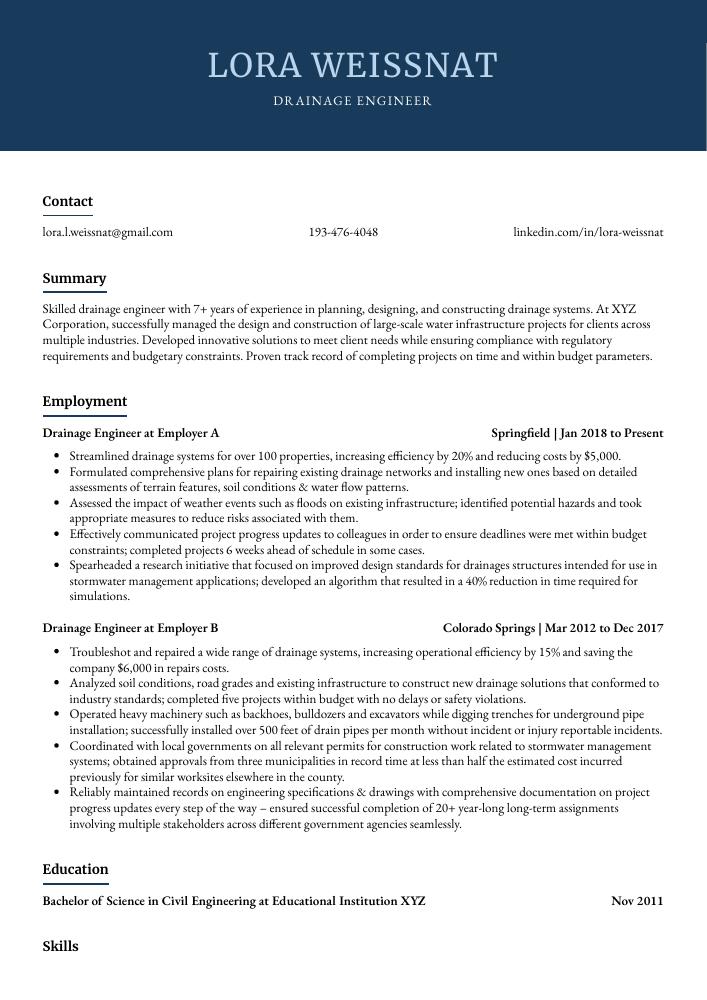Drainage Engineer Resume Guide
Drainage Engineers are responsible for designing and constructing systems to manage water runoff from a variety of sources. They analyze watersheds, develop plans for stormwater management, study the effects of land development on drainage patterns, inspect existing structures and recommend improvements or repairs. Additionally, they may also be involved in flood control projects or erosion prevention efforts.
Your knowledge of drainage systems and engineering would make you an invaluable asset to any construction firm. But employers don’t know who you are yet, so it’s essential that your resume stands out from the crowd and showcases your expertise in this field.
This guide will walk you through the entire process of creating a top-notch resume. We first show you a complete example and then break down what each resume section should look like.
Table of Contents
The guide is divided into sections for your convenience. You can read it from beginning to end or use the table of contents below to jump to a specific part.
Drainage Engineer Resume Sample
Lora Weissnat
Drainage Engineer
[email protected]
193-476-4048
linkedin.com/in/lora-weissnat
Summary
Skilled drainage engineer with 7+ years of experience in planning, designing, and constructing drainage systems. At XYZ Corporation, successfully managed the design and construction of large-scale water infrastructure projects for clients across multiple industries. Developed innovative solutions to meet client needs while ensuring compliance with regulatory requirements and budgetary constraints. Proven track record of completing projects on time and within budget parameters.
Experience
Drainage Engineer, Employer A
Springfield, Jan 2018 – Present
- Streamlined drainage systems for over 100 properties, increasing efficiency by 20% and reducing costs by $5,000.
- Formulated comprehensive plans for repairing existing drainage networks and installing new ones based on detailed assessments of terrain features, soil conditions & water flow patterns.
- Assessed the impact of weather events such as floods on existing infrastructure; identified potential hazards and took appropriate measures to reduce risks associated with them.
- Effectively communicated project progress updates to colleagues in order to ensure deadlines were met within budget constraints; completed projects 6 weeks ahead of schedule in some cases.
- Spearheaded a research initiative that focused on improved design standards for drainages structures intended for use in stormwater management applications; developed an algorithm that resulted in a 40% reduction in time required for simulations.
Drainage Engineer, Employer B
Colorado Springs, Mar 2012 – Dec 2017
- Troubleshot and repaired a wide range of drainage systems, increasing operational efficiency by 15% and saving the company $6,000 in repairs costs.
- Analyzed soil conditions, road grades and existing infrastructure to construct new drainage solutions that conformed to industry standards; completed five projects within budget with no delays or safety violations.
- Operated heavy machinery such as backhoes, bulldozers and excavators while digging trenches for underground pipe installation; successfully installed over 500 feet of drain pipes per month without incident or injury reportable incidents.
- Coordinated with local governments on all relevant permits for construction work related to stormwater management systems; obtained approvals from three municipalities in record time at less than half the estimated cost incurred previously for similar worksites elsewhere in the county.
- Reliably maintained records on engineering specifications & drawings with comprehensive documentation on project progress updates every step of the way – ensured successful completion of 20+ year-long long-term assignments involving multiple stakeholders across different government agencies seamlessly.
Skills
- Drainage
- Civil Engineering
- AutoCAD
- Engineering
- Stormwater Management
- Hydrology
- Water
- Hydraulics
- Water Resources
Education
Bachelor of Science in Civil Engineering
Educational Institution XYZ
Nov 2011
Certifications
Certified Drainage Engineer
American Society of Agricultural and Biological Engineers
May 2017
1. Summary / Objective
Your resume summary/objective should give the employer an overview of your experience and qualifications as a drainage engineer. In this section, you can highlight your technical knowledge in areas such as hydrology, hydraulics, geotechnical engineering and soil science. You could also mention any relevant certifications or awards that demonstrate your expertise in these fields. Finally, emphasize how you have successfully designed effective drainage systems for various projects while meeting tight deadlines and budget constraints.
Below are some resume summary examples:
Enthusiastic drainage engineer with 8+ years of experience in designing and implementing drainage systems to ensure compliance with regulations. At XYZ, successfully completed 3 projects involving large-scale drainage works within a tight budget and timeframe. Skilled at using advanced software tools like Civil 3D for design work and AutoCAD for project documentation. Proven track record of delivering high quality results on time while maintaining safety standards.
Well-rounded drainage engineer with 12+ years of experience designing, installing, and maintaining drainage systems for a wide range of clients. Proven track record in providing cost-effective solutions that exceed industry standards and meet customer requirements. At XYZ Company, reduced project costs by 20% through developing innovative designs to minimize construction time. Seeking to join ABC Engineering as the next Drainage Engineer on their team.
Seasoned drainage engineer with extensive experience in the planning and design of drainage systems. Skilled at analyzing hydrology data sets, developing hydraulic models to simulate water flow, and designing effective solutions for stormwater management. At XYZ, successfully designed a solution that improved water quality by 40%. Highly organized individual who can take initiative on any project from concept to completion.
Energetic drainage engineer with 8+ years of experience in water and wastewater infrastructure design, installation, and maintenance. Experienced in developing drainage strategies for residential, commercial, and industrial sites. At XYZ Company developed a comprehensive plan to mitigate flood risks for the city of ABCD that prevented $3M worth of damages due to heavy rainfall events over the past 5 years.
Detail-oriented drainage engineer with 8 years of experience in the design and implementation of large-scale drainage systems. Proven track record of success in meeting deadlines, delivering projects on time and within budget, resolving complex engineering problems, and driving innovation. Committed to joining ABC Engineering to help develop world-class solutions for draining water from urban areas.
Reliable drainage engineer with 7+ years of experience designing, constructing and maintaining drainage systems. Seeking to join ABC Tech’s team in order to utilize my extensive knowledge of civil engineering principles and sustainable practices while creating efficient water management solutions for their clients. Successfully designed a new stormwater system that reduced flooding by over 25%.
Professional drainage engineer specializing in the design, installation, and maintenance of drainage infrastructure. 8+ years’ experience with a proven track record of completing projects on time and within budget. Looking to leverage my expertise in hydraulic engineering principles at ABC Tech to create effective water management solutions for clients across multiple industries.
Driven drainage engineer with 8+ years of experience developing and managing small to large-scale projects. Seeking an opportunity at ABC Engineering where I can utilize my expertise in hydrological modeling, design, installation, and maintenance of drainage systems. Successfully completed over 100 irrigation projects while reducing overall cost by 20%.
2. Experience / Employment
Next comes the work history section, which should be written in reverse chronological order, with your most recent job listed first. Stick to bullet points here; this will make it easier for the reader to take in what you have done and achieved.
When writing out each point, provide as much detail as possible about what you did and the results that were obtained. For example, instead of saying “Installed drainage systems,” you could say, “Successfully installed 40+ drainage systems per month using a variety of materials such as PVC pipes and concrete blocks.”
To write effective bullet points, begin with a strong verb or adverb. Industry specific verbs to use are:
- Designed
- Installed
- Inspected
- Calculated
- Analyzed
- Constructed
- Operated
- Monitored
- Researched
- Repaired
- Adjusted
- Tested
- Troubleshot
- Documented
- Evaluated
Other general verbs you can use are:
- Achieved
- Advised
- Assessed
- Compiled
- Coordinated
- Demonstrated
- Developed
- Expedited
- Facilitated
- Formulated
- Improved
- Introduced
- Mentored
- Optimized
- Participated
- Prepared
- Presented
- Reduced
- Reorganized
- Represented
- Revised
- Spearheaded
- Streamlined
- Structured
- Utilized
Below are some example bullet points:
- Inspected and maintained drainage systems and pipelines on a monthly basis, ensuring that all safety standards were met; decreased breakdowns by 25%.
- Monitored water levels in canals and reservoirs to detect blockages or contaminants, averting flooding incidents during heavy rainfalls with an accuracy rate of 95%.
- Facilitated the installation of new sewer lines for over 50 households within a 3-month period, exceeding the project deadline by 2 weeks.
- Presented innovative solutions to improve drainage efficiency among various local communities; achieved cost savings up to $1300 per household annually due to reduced energy usage from improved flow rates.
- Competently managed budget constraints while developing plans for multiple large-scale flood prevention schemes across 10 villages, delivering projects under budget without compromising on quality standards.
- Accurately designed and maintained drainage systems for over 100 residential properties, ensuring that all necessary safety regulations were met.
- Participated in the installation of over 35 miles of underground piping to meet customer requirements; decreased leakage rates by 20%.
- Designed efficient stormwater management solutions for large-scale commercial projects, resulting in $75K saved on construction costs through improved water diversion techniques.
- Repaired a variety of drainage issues including clogged pipes, broken manhole covers and faulty sewage system components with an average response time of 4 hours or less per job request.
- Prepared detailed reports outlining repair methods used and their associated costs while providing customers with cost-effective alternative solutions where applicable.
- Evaluated and identified drainage issues in more than 50 residential and commercial properties, increasing satisfaction rate by 22%.
- Tested for infiltration and exfiltration of wastewater systems to ensure compliance with EPA standards; reduced the risk of water contamination by 28%.
- Achieved a 98% success rate on all projects involving pipe installation, repair and maintenance within deadlines.
- Developed solutions for complex drainage problems such as subsurface clogging through innovative techniques that saved clients an average of $5,000 in labor costs annually.
- Diligently inspected existing sewage systems regularly to detect any potential defects or blockages before they become serious problems; prevented up to 20 flooding incidents per year over the last 5 years due to proactive actions taken immediately upon detection of system failures.
- Optimized efficiency of drainage systems by 20% through revising existing design plans and constructing new piping networks.
- Calculated water flow rates, pipe diameters and gradients with accuracy to ensure that drainage systems could operate effectively within the given parameters.
- Revised existing designs for stormwater management to meet local regulations; collaborated closely with department heads throughout the process.
- Actively managed multiple projects simultaneously, ensuring timely completion of all tasks within budgetary constraints; successfully completed 4 large-scale drainage system installations in a 6-month period ahead of schedule despite challenging weather conditions.
- Utilized AutoCAD drafting software on a daily basis to create detailed drawings and schematics for clients’ review prior to construction commencement; increased client satisfaction ratings by 13%.
- Mentored and trained 4 junior engineers in the installation and maintenance of drainage systems, leading to a 25% decrease in repair costs.
- Structured new installations for over 50 residential and commercial properties, ensuring that all local regulations were met; increased customer satisfaction ratings by 15%.
- Introduced innovative best practices for drainage system management which reduced blockages by 20%, saving an estimated $5,000 per year on repairs and cleaning services.
- Substantially improved service delivery times through better coordination between engineering teams; reduced project completion time from 12 weeks to 8 weeks on average.
- Demonstrated expertise in using construction equipment such as excavation machines when carrying out complex drain excavations with minimal disruption or environmental damage caused.
- Represented engineering team in 15+ major drainage projects, providing advice and guidance to municipal governments on the designing of efficient stormwater systems.
- Advised over 200 clients on storm drain installation and repair issues; increased customer satisfaction scores by 20% within first year of service.
- Consistently monitored the performance of existing drainage structures, identifying areas for improvement and reorganized infrastructure plans accordingly to ensure maximum efficiency at all times.
- Reorganized water flow patterns using advanced software programs such as AutoCAD 3D Max Design; reduced flooding incidences in local communities by 45%.
- Researched new technologies related to urban flood control management strategies and recommended cost-effective solutions that achieved desired outcomes with minimum investment costs – saving $15,000 annually for municipal agencies across 10 counties nationwide.
- Expedited drainage projects by 20%, increasing efficiency and saving $10,000 in labor costs.
- Improved drainage systems of multiple residential areas through the implementation of new technologies; resulted in a reduction of flooding incidents by 75%.
- Reduced water contamination levels by 35% using specialized filtration techniques on all sewer lines maintained within city limits.
- Compiled detailed reports on system analysis, maintenance schedules and project timelines for each assigned job as required; provided clients with accurate estimates for upcoming jobs to ensure customer satisfaction.
- Confidently identified potential problems during inspection process, providing corrective solutions that saved customers up to $15,000 in repairs over time.
- Installed over 250 drains, sewers and pipes in both domestic and commercial settings, ensuring compliance with all safety regulations.
- Adjusted parts of existing sewer systems to ensure proper drainage for over 50 clients; successfully reduced flooding incidences by 25%.
- Meticulously inspected drainpipes using CCTV cameras to identify potential blockages or damage prior to repair works; identified issues before they became critical saving the company an estimated $10,000 in repairs costs.
- Documented detailed reports on findings from inspections as well as any work done during project completion; effectively communicated results between team members and supervisors while maintaining records of efficient workflow processes.
- Constructed complex drainage layouts ranging from terrain models to hydraulic calculations based on blueprints provided by architects; completed projects within budget parameters set by management each time (+$15k).
3. Skills
Skill requirements will differ from one employer to the next; this can easily be ascertained from the job posting. Organization A may require experience with stormwater management, while Organization B may require knowledge of flood control systems.
It is important to tailor the skills section of your resume to each job that you are applying for. This is because most employers use applicant tracking systems these days, which scan resumes for certain keywords before passing them on to a human.
Once listed here, it’s also beneficial to discuss your qualifications in more detail in other areas such as the summary or experience sections.
Below is a list of common skills & terms:
- ArcGIS
- AutoCAD
- CAD
- Civil Engineering
- Drainage
- Engineering
- Environmental Awareness
- Environmental Engineering
- Hec Ras
- Highways
- Hydraulics
- Hydrology
- MATLAB
- MicroStation
- Project Planning
- Road
- Sewer
- Stormwater Management
- Surveying
- Team Leadership
- Teamwork
- Time Management
- Transportation Engineering
- Water
- Water Quality
- Water Resources
4. Education
Including an education section on your resume depends largely on how far along you are in your career. If you just graduated and have no prior experience, mention your educational qualifications below the resume objective. However, if you already have a few years of work experience as a drainage engineer that is more relevant to the job role than what was studied at university or college, then it might be best not to include an education section altogether.
If including an education section is necessary, try to highlight courses and subjects related specifically to drainage engineering so employers can see that you possess the appropriate knowledge for this position.
Bachelor of Science in Civil Engineering
Educational Institution XYZ
Nov 2011
5. Certifications
Certifications are a great way to demonstrate your knowledge and expertise in a particular field. They show potential employers that you have taken the time to gain an official qualification, which is highly valued by many organizations.
Including certifications on your resume can be beneficial when applying for jobs as it will give hiring managers confidence in your abilities and qualifications related to the position they are looking for. Be sure to list any relevant certifications you possess so that recruiters can easily see them at first glance.
Certified Drainage Engineer
American Society of Agricultural and Biological Engineers
May 2017
6. Contact Info
Your name should be the first thing a reader sees when viewing your resume, so ensure its positioning is prominent. Your phone number should be written in the most commonly used format in your country/city/state, and your email address should be professional.
You can also choose to include a link to your LinkedIn profile, personal website, or other online platforms relevant to your industry.
Finally, name your resume file appropriately to help hiring managers; for Lora Weissnat, this would be Lora-Weissnat-resume.pdf or Lora-Weissnat-resume.docx.
7. Cover Letter
Writing a cover letter is an important part of the job application process. It gives you a chance to introduce yourself and explain why you are a great fit for the role. A cover letter is typically made up of 2-4 paragraphs and should be tailored specifically to each position that you apply for.
It’s not mandatory for all roles, but it can help give recruiters more insight into who you are as an individual and what value your skills would bring to their company. Crafting a well-written cover letter could be just what sets your resume apart from other candidates’.
Below is an example cover letter:
Dear Sophie,
I am writing in response to your ad for a Drainage Engineer. With my experience designing and overseeing the construction of drainage systems, I am confident I would make a valuable contribution to your team.
As Lead Drainage Engineer at XYZ Engineering, I was responsible for the design and implementation of several high-profile projects, including the ABC Highway expansion and the XYZ Dam renovation. In both cases, I successfully managed teams of engineers and technicians while coordinating with other departments to ensure the project stayed on schedule and within budget. My strong communication skills were essential in keeping all stakeholders informed throughout each project’s lifecycle.
In addition to my engineering experience, I have a Master’s degree in Civil Engineering from XYZ University. My coursework included hydraulics, hydrology, fluid mechanics, and other relevant topics that have prepared me well for this role.
I would welcome an opportunity to put my skills and experience to work for you as part of your drainage engineering team. Please contact me at [phone number] or [email address] so we can discuss how I can contribute to your organization’s success. Thank you for your time!
Sincerely,
Lora
Drainage Engineer Resume Templates
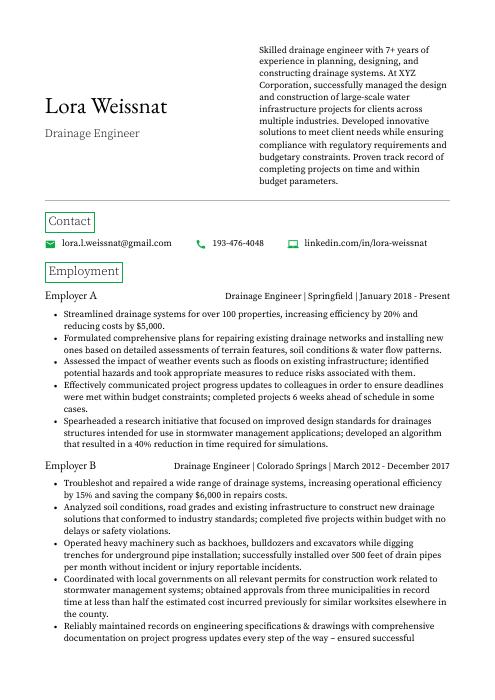 Quokka
Quokka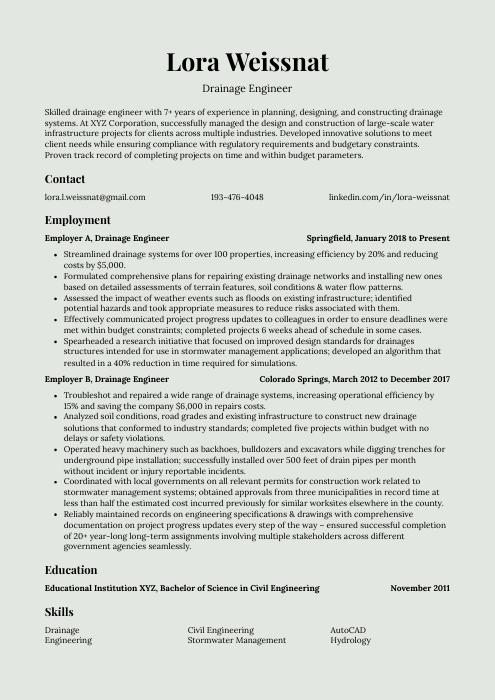 Saola
Saola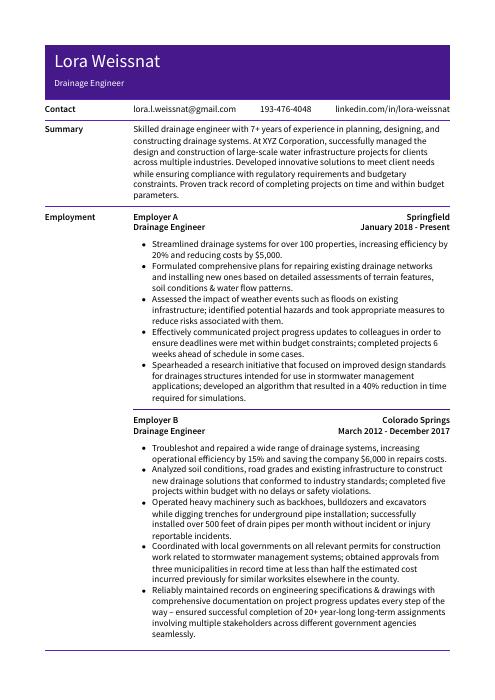 Pika
Pika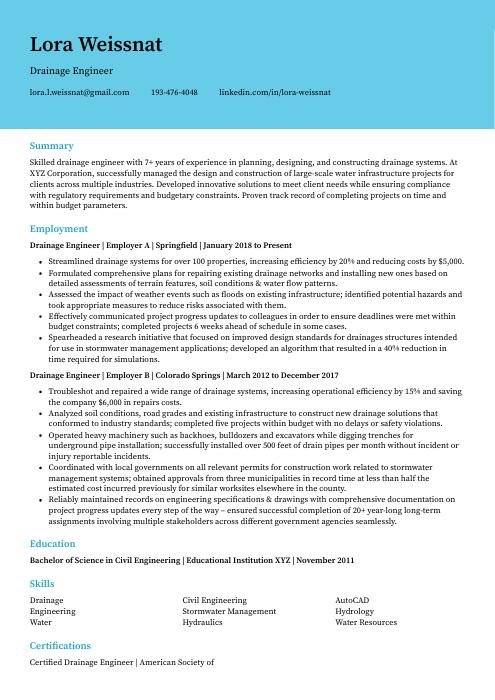 Dugong
Dugong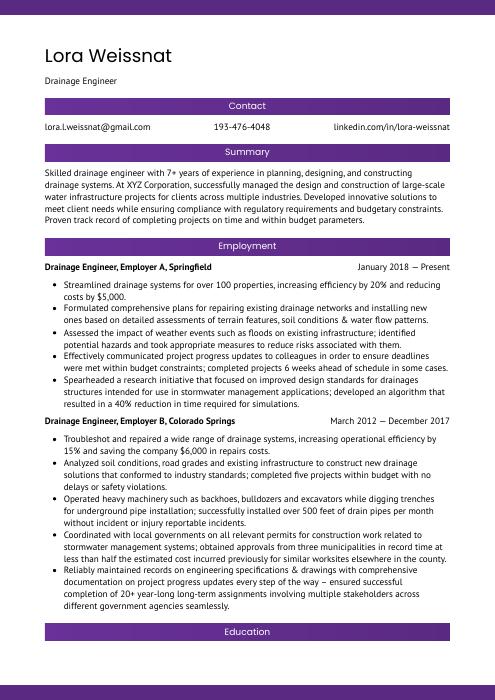 Jerboa
Jerboa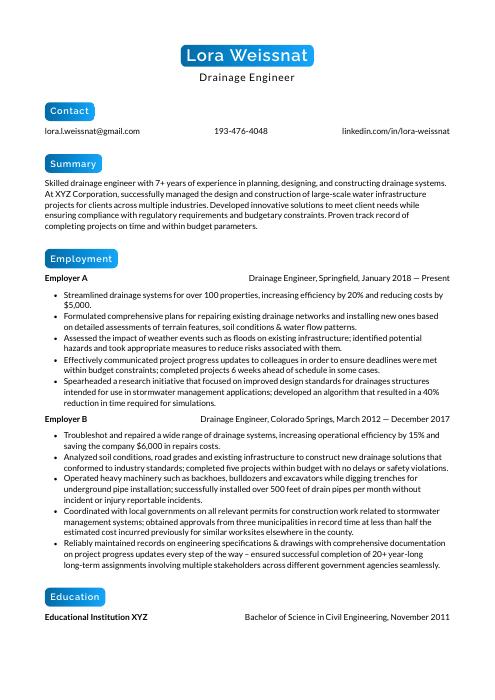 Kinkajou
Kinkajou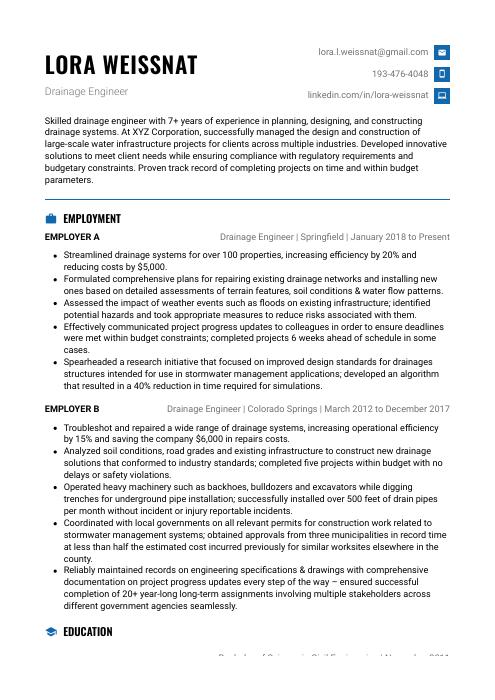 Echidna
Echidna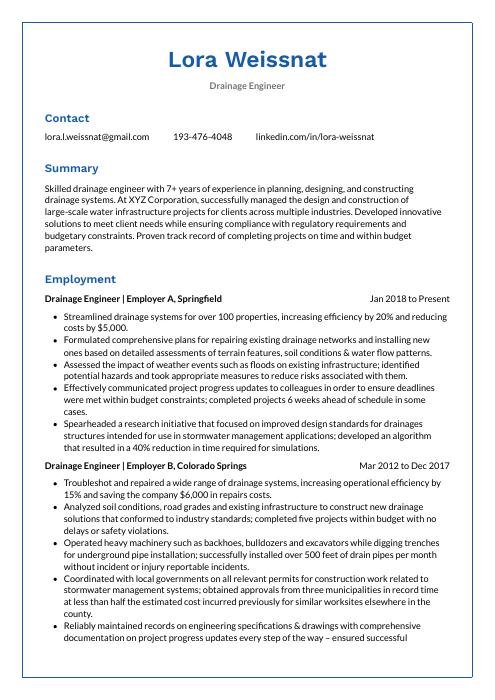 Markhor
Markhor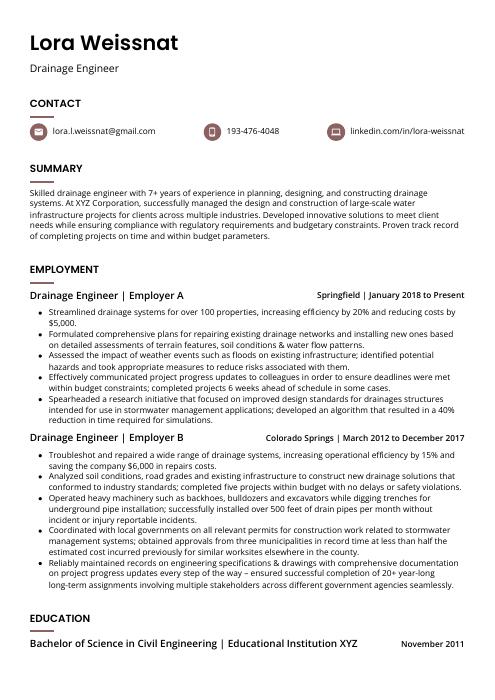 Fossa
Fossa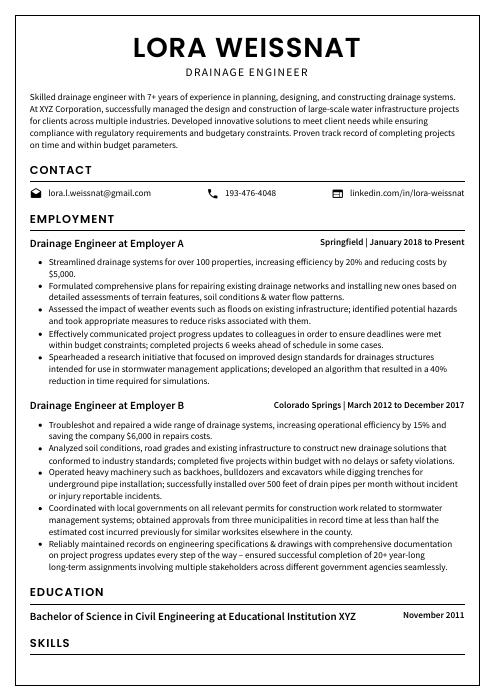 Cormorant
Cormorant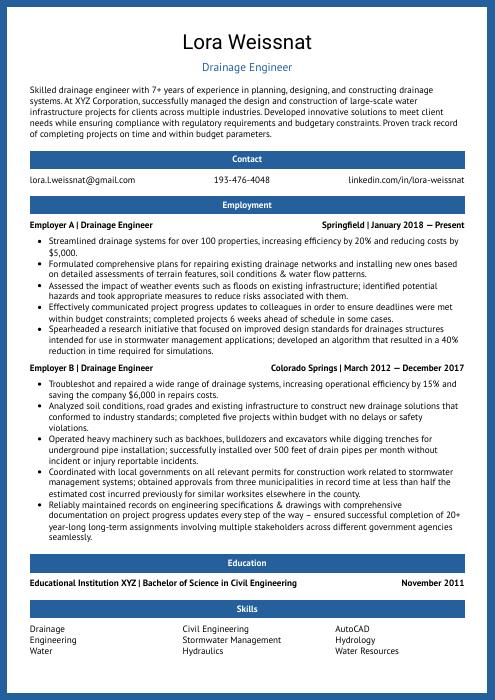 Ocelot
Ocelot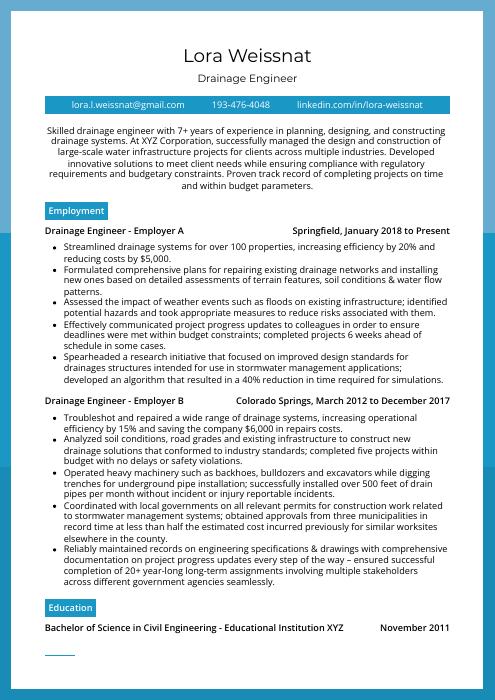 Rhea
Rhea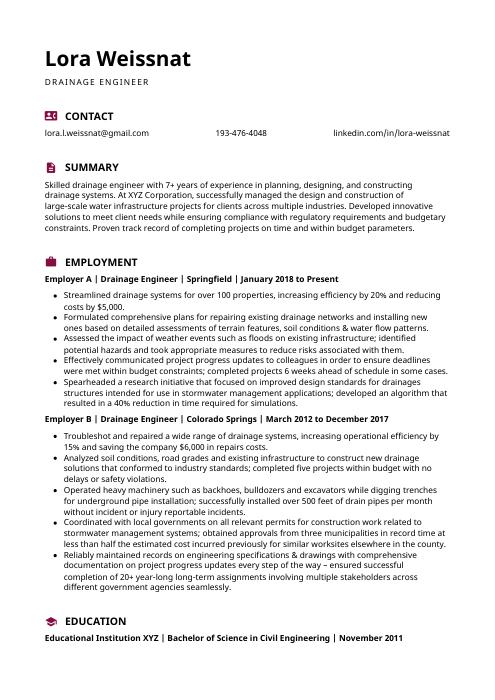 Hoopoe
Hoopoe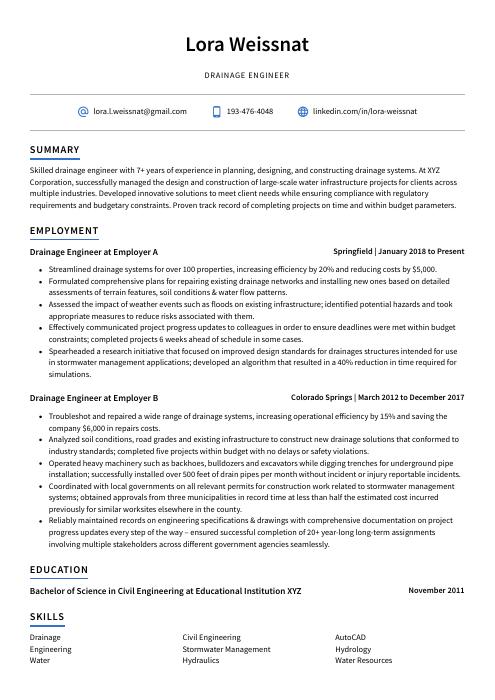 Axolotl
Axolotl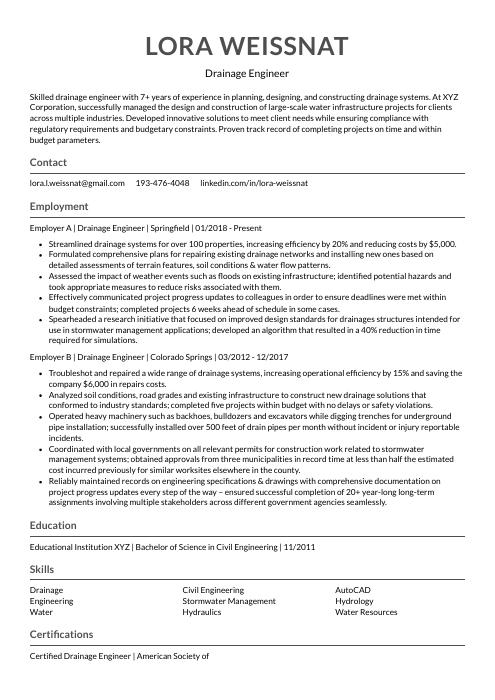 Indri
Indri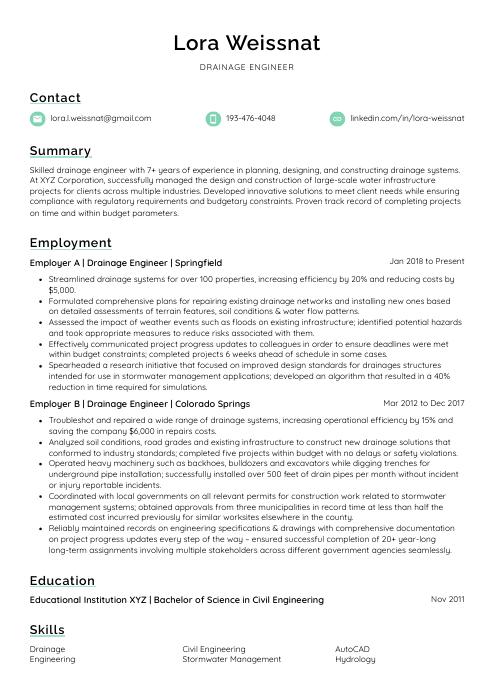 Lorikeet
Lorikeet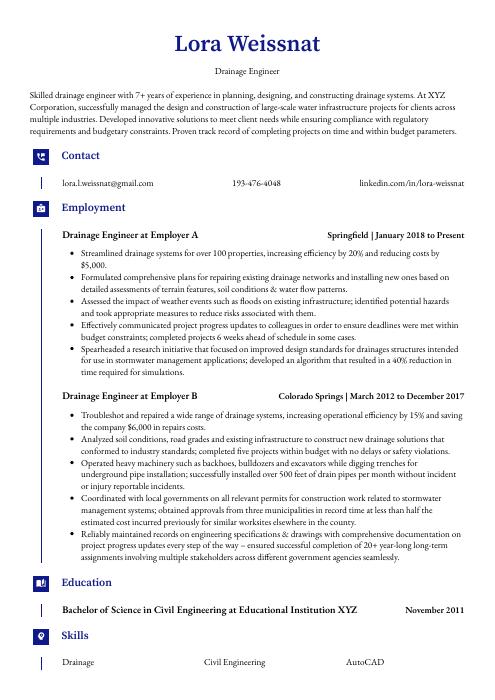 Gharial
Gharial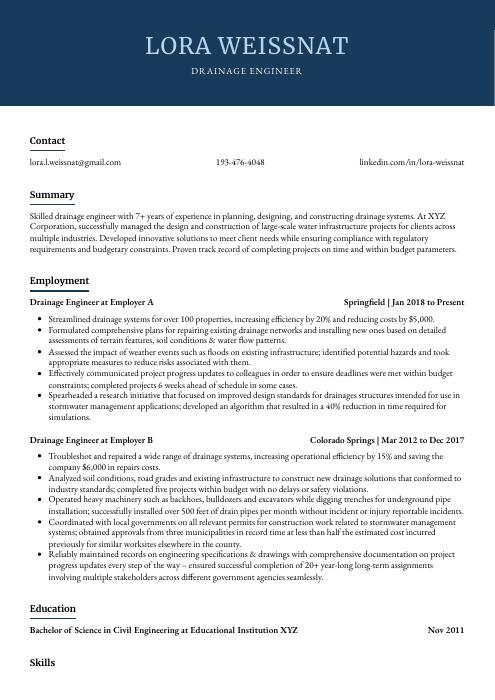 Bonobo
Bonobo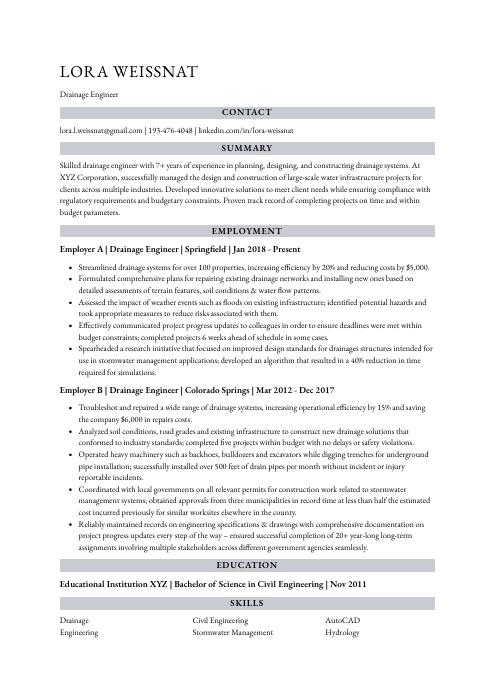 Numbat
Numbat Rezjumei
Rezjumei
